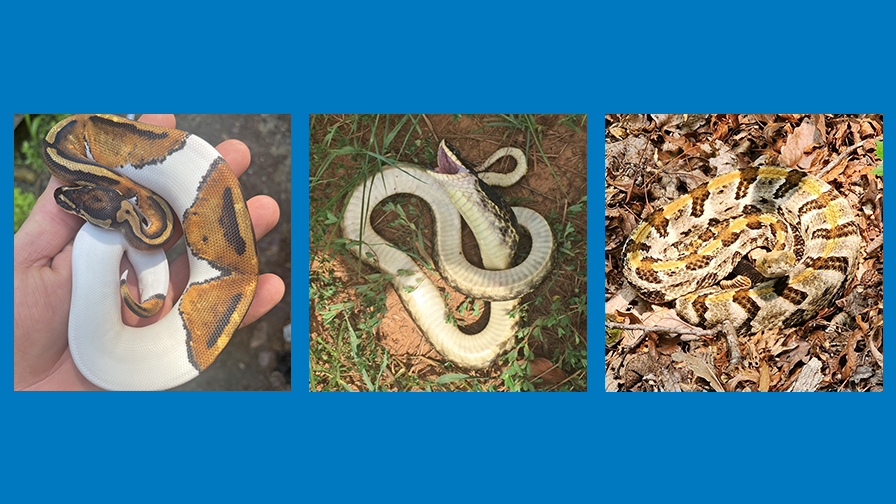- Vegetation Management Services
- Industries
- In Your Neighborhood
- About
- Careers
- Webinars
- Articles
Coexisting with Herps in Rights-of-Way

Coexisting with Herps in Rights-of-Way
By Joshua Justice, Assistant Operations Manager, ACRT
I am a forest technician by trade, an operations manager in the utility vegetation management (UVM) industry, and a reptile enthusiast at heart. I have been practicing herpetoculture — the keeping of live reptiles and amphibians in captivity — as a hobby for well over three decades.
Through many years of research in learning to provide optimal care for these reptiles and amphibians, and to increase my chance of finding them in the wild for photographic purposes, I have learned the general requirements for herp survival and in what scenarios they thrive.
My experience with these species and working in utility easements has influenced me to explore the topic further to highlight the suitable habitat that is provided through UVM and the best practices for coexisting with reptiles.
If you were to ask me what the perfect habitat would be for most reptiles, I would say a location with many basking spots, near cover areas of variable humidity levels, somewhere with a water source, and ample locations for prey animals to reproduce and flourish.
To a landowner, the log left lying along an easement edge to decay might be an eyesore, but to a snake, it is a perfect spot to thermoregulate between the sun and shade and to ambush prey. Add a cavity in the log and it is an even better habitat because it creates an additional hide with a different humidity level. Increase that to a stack of logs…well, you get the idea.
Additionally, mowing and herbicide activities often keep utility easements in an early stage of succession, with plants such as blackberry, grasses, and forbs that provide suitable cover and food sources for carnivorous reptiles to prey on, which can include rodents, smaller reptiles, insects, and amphibians.
Given suitable food availability, and various integrated vegetation management (IVM) techniques creating fragmentation and microclimates, herps can often thrive better in utility easements than in native habitats.
While it is no secret that there are certain reptiles that present a risk to human health and safety, in the U.S., it is very rare that an individual will be bitten by a venomous snake and far less likely that a bite will result in a fatality. According to the University of Florida Department of Wildlife Ecology & Conservation, fewer than one in 37,500 people are bitten by a venomous snake in the U.S. each year, and only one in 50 million people will die (five to six fatalities per year), meaning your chance of dying from a venomous snake bite is next to zero. Keep in mind that these numbers likely include folks who are attempting to handle snakes.
To shed light on this, you are three times more likely to die from a dog bite and six times more likely to die from being struck by lightning. Reptilian nature is far less scary than what some folks have been taught to believe, and reptiles are some of the most amazing, misunderstood creatures on the planet.
Having worked with herps for most of my life, I’ve found that they generally bite for one of two reasons, either to subdue prey or to defend themselves. They will often be very tolerant of stimuli in a defense situation, only biting when other options such as escape have been exhausted. Reptiles, even venomous ones, play a valuable role in native ecosystems controlling rodent populations, potentially reducing disease, and helping with the balance of nature.
So, how do we coexist with reptiles? First off, practice tolerance. Snakes and lizards are just creatures trying to survive. They want to eat, reproduce, and feel safe, much like humans do, and they will go to great lengths to avoid confrontation. We should give them that mutual respect and just choose to let them go their way while we head in the other direction.
Second, we can control where their habitat is to a degree, by limiting brush, logs, and hide areas around our homes, while allowing suitable habitat on our properties and being aware of our surroundings while enjoying our time spent outdoors.
Third, it’s all about perspective. As humans, we can change our perspective to influence what gives us pleasure. When we add viewing wildlife as a hobby or enjoyable experience, our whole outlook can change. I often like to think about all the money folks spend controlling dandelions in their yard, and how much they would save if they only appreciated the dandelion for its beauty and edibility. Like I said before, it is all about perspective.
We have made the choice to coexist with reptiles. How do we respect them, while at the same time protecting ourselves?
- Reptiles do not want attention. Give them their space and avoid close encounters.
- Do not try to handle or kill reptiles. Bites can occur during these attempts.
- Educate yourself. Learn to identify the reptiles in your area, particularly venomous ones, and their mimics.
- Enjoy them and even photograph them but at a safe distance. Most snakes can strike up to half of their total length.
- Help to maintain and provide suitable habitat on properties, but limit habitat in areas that are in very close proximity to the home or recreational areas.
- Remember that reptiles are as harmless as you will allow them to be.
While the chance of getting a snake bite is rare, I wanted to give a little guidance on how to respond in the unlikely event you are bitten.
- Try to identify the snake. Remember the colors and shape of the snake.
- Keep the bitten person calm. This can slow the spread of venom.
- Seek medical attention.
- Apply first aid if you can’t get immediate medical attention. Wash the wound with warm, soapy water immediately. Cover the bite with a clean, dry dressing.
- Sit down and keep the bite below heart level.
Never try to catch the snake. Do not apply a tourniquet. Please do not cut the wound open or try to suck the venom out as this can cause more damage. Do not apply ice to the bite. Avoid caffeine and alcohol.
Related Articles

Servant Leadership in Utility Vegetation Management By C. Troy Ross, President, ACRT and ACRT Pacific On a chilly Monday morning, a utility vegetation management crew gathers for their weekly briefing. Instead of launching into instructions, their supervisor begins by asking each team member how they’re doing. One mentions a child’s illness, another shares excitement about[...]
Read More
Turning Vegetation Waste into Opportunity By Aana Agrawal, Sustainability and Resilience Manager, EnviroScience The utility vegetation management (UVM) sector plays a crucial role in ensuring the smooth transmission of power across regions and cities by keeping plant growth under control within the vicinity of transmission and distribution lines. However, unrefined vegetation maintenance practices often focus[...]
Read More
Reflections from Will Nutter Silver Shield Award Recipients By Bob Urban, Senior Manager, ACRT Services In an industry where the stakes are high and every decision can have life-altering consequences, leadership in utility arboriculture isn’t just a managerial function; it’s a calling. Nowhere is this more evident than in the recipients of the Will Nutter[...]
Read More
The Electric Butterfly: Reconnecting with Nature on the Edges By Ryan Meccage, Business Development Manager, ACRT Services In an age dominated by smartphones, constant connectivity, and algorithm-driven content, we’ve never been more digitally immersed. Yet somehow, we’ve also never felt so far removed from the natural world beneath our feet. The urge to step away[...]
Read MoreRecent Posts
- Alex Fields Awarded ACRT Safety Challenge Coin 20th Nov 2025
- Servant Leadership in Utility Vegetation Management 12th Nov 2025
- ACRT Honors Our Veterans 10th Nov 2025
- Anna Davis Awarded Safety Challenge Coin 04th Nov 2025
- ACRT Senior Consulting Utility Forester Recognized as Safety Superstar 15th Oct 2025
Categories
The Leader In Vegetation Management
We are all about people, and we put safety first. Ready to work with our well-trained team?